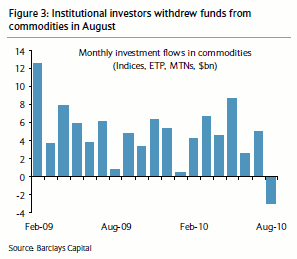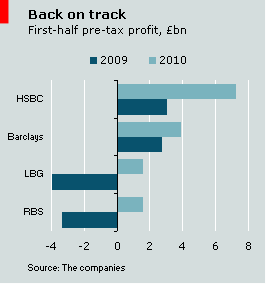You are currently browsing the tag archive for the ‘Barclays’ tag.
Tag Archive
UK banks: A reprieve, of sorts
July 20, 2011 in Banks | Tags: Barclays, HSBC, interbank lending, Lloyds Banking Group, RBS, stress test, UK | Leave a comment
British banks received a fillip from parliament today, as the Treasury Select Committee called for “more detailed analysis” of the proposal to ring-fence banks’ retail units from the rest of their operations. Banks have criticised the proposal, made by the Independent Commission on Banking, as saddling them with unnecessary costs and restraining their capacity to lend. Signs of a rethink on the proposal sent British banks’ shares sharply higher.

The rally reversed steep declines following Friday’s EU stress test. Although all four of the British banks in the test passed, some of the details that emerged about the banks’ balance sheets spooked investors. In particular, funding costs soared in the test’s “adverse” scenario—which many analysts, including the EIU, think was not nearly adverse enough. The cost of funding for Barclays, for example, rose almost four-fold between 2010 and 2012 in the test, the largest jump in the 90-bank sample. The other British banks in the sample also saw above-average increases in costs, thanks in part to reliance on wholesale funding sources.
Exposure to fickle wholesale markets is one of the reasons cited in favour of erecting firewalls around universal banks’ retail activities. Any new analysis of the retail ring-fence idea should take the implications of banks’ enduring reliance on short-term interbank markets into account.
Article of the week: The future of banking in Britain
April 22, 2011 in Banks | Tags: Barclays, EIU, HSBC, Lloyds, RBS, UK | Leave a comment
The majority of data and analysis at Financial Services Briefing is available only to subscribers. Each week, a small share of content from the service is made available to non-subscribers.
“Straightforward to characterise, but difficult to quantify”. The Independent Commission on Banking (ICB), a group assembled by the British government to make recommendations on regulatory reforms, delivered its interim report on April 11th. “Everyone agrees that we need a much more robust banking system than that of the past decade”, said Sir John Vickers, the ICB’s chairman.
 A week after the report’s publication, markets continue to mull the implications of the report, as well as the prospects for British banking in general. Tellingly, the initial rally in many banks’ shares immediately following the release of the report quickly fizzled, with all of the major banks now trading below the levels seen on the eve of the report’s publication
A week after the report’s publication, markets continue to mull the implications of the report, as well as the prospects for British banking in general. Tellingly, the initial rally in many banks’ shares immediately following the release of the report quickly fizzled, with all of the major banks now trading below the levels seen on the eve of the report’s publication
It appears that the UK’s approach to restructuring its banking system will rely on higher capital requirements for retail units and an attempt to engineer a viable “challenger” to the biggest banks from the portfolio of Lloyds Banking Group. Other countries with significant financial centres, like Switzerland, have already gone further on capital requirements while others, like the US, have been stricter on limiting the market share of major players.
It may take years to judge whether regulators can promote a more stable and competitive banking market in the UK. In the meantime, markets have shorter-term concerns.
Read more at Financial Services Briefing: “For better or worse” (April 20th)
Commodity investing: Cautiously optimistic
September 23, 2010 in Asset managers, Economy, Exchanges | Tags: Barclays, commodities, World | Leave a comment
The latest quarterly economic outlook from Barclays Capital includes a relatively upbeat chapter on commodities. As the strategists summarise:
Whilst the global economy still faces major uncertainties, the growth outlook for the remainder of 2010 looks reasonably benign, fundamentals are improving steadily in many individual commodity sectors and market participants may be underestimating the potential for significant price gains in Q4.

In highlighting the “nervous drivers” of demand among commodity investors, BarCap notes that August saw the first net outflow of funds from commodities since the bank started tracking these flows in 2009. Gold, however, bucked this trend; it has accounted for around a third of the US$29bn in commodity inflows so far this year. This, in itself, reflects the unease over the economic outlook that drove investors to trim exposure to other commodities. Although BarCap expects this anxiety to become less acute and overall commodity demand to recover in the fourth quarter, “the path ahead is likely to prove bumpy”.
Article of the week: Britain’s banks
August 7, 2010 in Banks | Tags: Barclays, earnings, EIU, HSBC, Lloyds Banking Group, RBS, UK | Leave a comment
The majority of data and analysis at Financial Services Briefing is available only to subscribers. Each week, a small share of content from the service is made available to non-subscribers.
The credit crunch was not kind to British banks. Many of the country’s lenders grew dangerously exposed to overheated property markets, exotic derivatives and flighty wholesale funding sources. When the financial crisis struck, these exposures pushed several banks to the brink (and beyond).

Against this dire background, the latest half-year results from the UK’s largest lenders represent a relatively swift return to health. The country’s biggest banks all reported profits for the first six months of this year. For part-nationalised RBS and Lloyds Banking Group, the profits marked a welcome break from a recent string of losses. For the other large domestic banks—HSBC and Barclays—robust increases in first-half results met or beat analysts’ expectations. The results reinforce the conclusions of the EU’s July stress test, which the British quartet passed comfortably.
Read more at Financial Services Briefing: “Recovery mode” (August 6th)
Article of the week: Dubai’s battered property market
February 5, 2010 in Banks, Economy | Tags: Barclays, Dubai, foreclosure, property, UAE | Leave a comment
The majority of data and analysis at Financial Services Briefing is available only to subscribers. Each week, a small share of content from the service is made available to non-subscribers.
 A victory for Barclays in Dubai’s first foreclosure case is a welcome development for lenders in the region. Although it marks an important step in the maturity of the emirate’s battered property market, it is unlikely to herald a flood of foreclosures.
A victory for Barclays in Dubai’s first foreclosure case is a welcome development for lenders in the region. Although it marks an important step in the maturity of the emirate’s battered property market, it is unlikely to herald a flood of foreclosures.
Read more at Financial Services Briefing: “Closing time” (January 29th)

